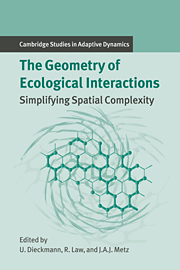Book contents
- Frontmatter
- Contents
- Contributing Authors
- 1 Introduction
- Part A Empirical and Statistical Background: A Plant Ecological Perspective
- Part B When the Mean-field Approximation Breaks Down
- Part C Simplifying Spatial Complexity: Examples
- Part D Simplifying Spatial Complexity: Techniques
- Introduction to Part D
- 18 Pair Approximations for Lattice-based Ecological Models
- 19 Pair Approximations for Different Spatial Geometries
- 20 Moment Methods for Ecological Processes in Continuous Space
- 21 Relaxation Projections and the Method of Moments
- 22 Methods for Reaction–Diffusion Models
- 23 The Dynamics of Invasion Waves
- 24 Epilogue
- References
- Index
- International Institute for Applied Systems Analysis
21 - Relaxation Projections and the Method of Moments
Published online by Cambridge University Press: 14 January 2010
- Frontmatter
- Contents
- Contributing Authors
- 1 Introduction
- Part A Empirical and Statistical Background: A Plant Ecological Perspective
- Part B When the Mean-field Approximation Breaks Down
- Part C Simplifying Spatial Complexity: Examples
- Part D Simplifying Spatial Complexity: Techniques
- Introduction to Part D
- 18 Pair Approximations for Lattice-based Ecological Models
- 19 Pair Approximations for Different Spatial Geometries
- 20 Moment Methods for Ecological Processes in Continuous Space
- 21 Relaxation Projections and the Method of Moments
- 22 Methods for Reaction–Diffusion Models
- 23 The Dynamics of Invasion Waves
- 24 Epilogue
- References
- Index
- International Institute for Applied Systems Analysis
Summary
Introduction
Theory in spatial ecology has to steer a narrow and challenging course between the Scylla of oversimplification and the Charybdis of intractability. Until about 15 years ago, most of theoretical ecology was based on the mean-field paradigm, thus targeting well-mixed ecological systems. Although the underlying assumption of spatial homogeneity is violated for many, if not most, ecological populations and communities in the field, mean-field approaches appeared to be the only way forward. They even took center stage in certain areas, as in epidemiological systems (Bailey 1975; Anderson and May 1991), today recognized as typical examples of ecological processes for which space matters. It was only with the advent and ready availability of modern computer technology that explorations into critical effects of spatial heterogeneities became feasible (Levin 1974, 1976; Weiner and Conte 1981; Weiner 1982; Pacala and Silander 1985; Holsinger and Roughgarden 1985; Pacala 1986; Hogeweg 1988). Today, computer screens and journals abound with images of spatially extended simulations that have convincingly demonstrated that many predictions of classical ecological theory are inappropriate in the presence of spatially structured habitats or short-range ecological interactions.
Despite their value as counterexamples to mean-field predictions and their usefulness in exploring the emergence of macroscopic effects resulting from microscopic ecological mechanisms, simulation studies often remain inconclusive. Are the reported phenomena robust under changed ecological parameters? Where, among the noisy dynamics of individual-based and stochastic models, is the ecological signal? How many (usually timeconsuming) spatial simulations have to be run before reliable conclusions can be drawn? These questions remind us that only part of our ecological understanding is based on description: on top of this, we look for mechanistic explanations and for reliable generalizations from observations.
- Type
- Chapter
- Information
- The Geometry of Ecological InteractionsSimplifying Spatial Complexity, pp. 412 - 455Publisher: Cambridge University PressPrint publication year: 2000
- 59
- Cited by



